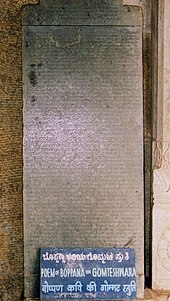Bahubali
The Adipurana, a 9th-century Sanskrit poem, deals with the ten lives of the first tirthankara, Rishabhanatha and his two sons Bharata and Bahubali.[7] After winning six divisions of earth in all directions (digvijaya), Bharata proceeded to his capital Ayodhyapuri with a huge army and divine chakra-ratna—spinning, disk-like super weapon with serrated edges.[10] The ministers on both sides gave the following argument to prevent war; "The brothers themselves, cannot be killed by any means; they are in their last incarnations in transmigration, and possess bodies which no weapon may mortally wound in warfare!Bahubali abandoned all possessions-kingdom, clothes, ornaments-to become a monk and began meditating with great resolve to attain omniscience (kevala jnana).A painful regret that he had been the cause of his elder brother's humiliation had been disturbing Bahubali's meditation; this was dispersed when Bharata worshipped him.The statue was commissioned by the Ganga dynasty minister and commander Chavundaraya; it is 57-foot (17 m) tall and is situated above a hill in Shravanabelagola, in the Hassan district of Karnataka.[19] Venur is a small town in Dakshina Kannada district, Karnataka state, situated on the bank of the Gurupura River.The 12th-century granite statue of Bahubali, also known as Gomateshwara, is erected atop a 50-metre (160 ft) tall hillock called 'Shravana Gudda'.[32] ASI has also excavated an 8th-century statue of Bahubali in Aretipur, Maddur, Mandya, Karnataka, that is 3 feet (0.91 m) wide and 3.5 ft (1.1 m) tall.







BaahubaliGommateshwara statueShravanabelagolaJainismAyodhyaRishabhaBharataHistoryTimelinePhilosophyAnekantavadaCosmologyAhimsaDharmaMokṣaKevala JnanaDravyaTattvaBrahmacaryaAparigrahaGunasthanaSaṃsāraEthics of JainismAhiṃsā (non-violence)Aparigraha (non-possession)SāmāyikaSallekhanaBhaktamara StotraMicchami DukkadamNavkar MantraṆamōkāra mantraJai JinendraThe 24 TirthankarasPārśvaMahaviraArihantGanadharaKundakundaSiddhasenadivākarasuriSamantabhadraHaribhadraYashovijayaSchools and BranchesDigambaraŚvetāmbaraJain literatureSamayasāra (Digambara)Pravachanasara (Digambara)Agama (Śvetāmbara)Tattvartha SutraDravyasamgraha (Digambara)Kalpa Sūtra (Śvetāmbara)Uttaradhyayana (Śvetāmbara)Cīvaka CintāmaṇiSilappatikaramValayapathiDiwaliMahavir Janma KalyanakParyushanaSamvatsariPalitanaGirnarShikharjiEkendriyaTemplesJain flagJain symbolsParasparopagraho JivanamTopics listRishabhanathatirthankarachakravartinkayotsargaAdipuranaSanskritJinasenaDigambara monkIkshvaku dynastymedicinearcheryfloricultureknowledge of precious gemsAsmakaSouth IndiaJain monksmalla-yuddhaBadami cavesĀdi purāṇakarmasKevalimokshaMount KailashaDigambara monksAvasarpiṇīmonolithicKarnatakaHassan DistrictKarkalaUdupi DistrictDharmasthalaDakshina KannadaGommatagiriMysore DistrictKolhapur districtThane districtTiruvannamalai DistrictBangaloreGanga dynastyChavundarayatirthaGommateshwara statue, KarkalaBhair Arasa dynastyDharmastalaGurupura RiverMahamastakabhishekaKumbhojMaharashtraMandya districtArchaeological Survey of IndiaMaddur, MandyaGommateshvara statueNemichandraKannadaAdikavi PampastanzasDabhoi